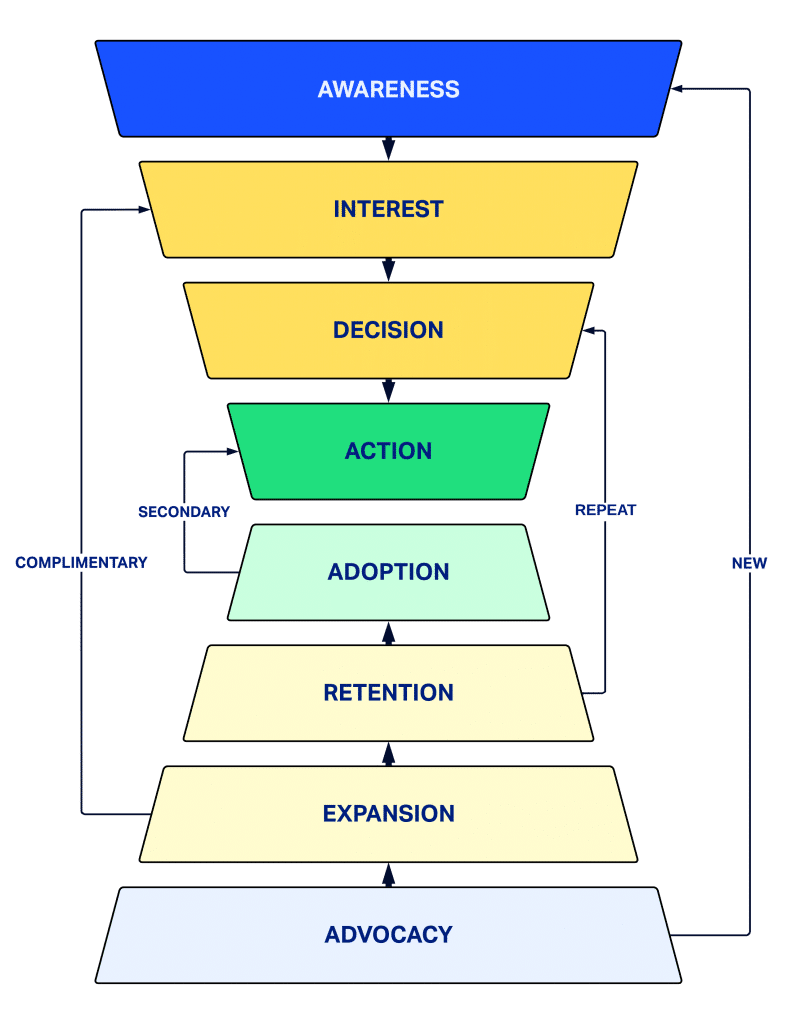The Marketing Wormhole is a concept visualization on how potential and repeat customers are discovered and hopefully moved to your end goal. Surely the visual of a wormhole appears in your head as two connected funnels with broad-opening entrances that then tapers into a concentrated point. This is the same for how most markets approach their strategy.
Table of contents
Discovery Funnel (Top Entry Wormhole)
The traditional marketing funnel is divided into 4 regions. Each region has its own set of entrance criteria, limitations, and intentions. Starting at the top there is normally a requirement for volume and a higher potential for those that are not interested to “spill” or miss the funnel completely and not progress further to your goal. As someone is either brought into or continues deeper through the funnel, the higher chance they will reach the goal. As a marketer, the objective is to get more people to the end portions of the funnel while keeping the potential cost low.
| Funnel Level | Quantity | Cost |
|---|---|---|
| Outer | High (100) | Lower ($1) |
| Inner | Moderate (30) | Moderate ($3.33) |
| Center | Lower (10) | Higher ($10) |
While the goal is to move customers through the funnel once, quite often the customer will appear in the funnel if they are not understood or categorized correctly. This could mean that the cost of moving the customer can be multiplied exponentially if not accounted for. On the flip-side a customer that comes through the funnel more often declines in their likelihood to exit as they have a considered higher intent at moving towards the goal.
| Funnel Level | First Exit % | Repeat Exit % |
|---|---|---|
| Outer | 90% | 70% |
| Inner | 60% | 40% |
| Center | 30% | 10% |
While considering the cost and exit percentage, the goal of the marketer is to enter and move the prospect though the correct part of the funnel the least amount of times between achieving goals. As a customer continues to meet the final objective, they should enter closer to the inner of the funnel and thus reduce the cost and provide better returns on the goals.
Awareness (Outer)
This part in the funnel is often the most elusive process to capture new customers, but also often helps reveal new opportunities or insight into them. Generally speaking, this is a wide net cast to get as many eyes on a message as possible and begin to hone in on those that are appropriate. You want to grab attention.
Common Types: General Brand Voice, Social Media, InfoGraphics, Events, Trade Shows, Blog posts, Sponsorships, Flyers
Interest (Inner)
A customer has started to review the brand and may have had some soft interactions. This could include liking a social media post, sharing a post to a friend/family, or comparing you to others that are similar to you. You want to share your value propositions.
Common Types: Specific Brand Message, Affinity or Target ads, First-Offer Email, Promotional Coupons
Decision (Inner)
This is the section of the wormhole where prospects are most likely to follow an action that directly moves them towards the goal/action.You want to be very clear on the intent they should follow.
Common Types: Site Visit, Email Open/Click, Created Cart, Product Page View, Favorite, Queued, Exit Links
Action (Center)
They did it, you did it! All of the marketing and messaging efforts lead to this moment where the prospect has finally completed the intended goal/action.You want to track this action as success.
Common Types: Purchase, Follow, Like, Subscribe, Time Spent on Site, Installs, Downloads, Exit Links

Repeat Funnel (Bottom Entry Wormhole)
Brands that intend to be competitive and innovative need to consider both the discovery and repeat funnel making a full-marketing wormhole. It is no longer enough to continue to bring newness into the fold, but also continue the engagement of those that are already in the mix. Often this part of the marketing plan happens at a point where a business has a solid foundation of practical opportunities. However this is becoming table-steaks as a company grows, since it often offers more organic and higher intent goal completions.
Adoption (Center)
The rate in which acquired users/customers are engaging with your core-offering or engaging in secondary or closely related actions. This could be an online purchase and store purchase OR an app purchase and an in-app purchase.
Retention (Inner)
Customers are interacting at a common rate/frequency, and the size of users making frequent decisions remains constant. This could take shape in a loyalty program, birthday rewards, or general timely engagement.
Expansion (Inner)
Using the network of engaged users to further grow through similar interests or affiliate networking.
Advocacy (Outer)
Current users help spread awareness through ratings & reviews, User-Generated Content (UGC), or other means in which they are providing the source of discovery voluntarily.
Conclusion
When time and money are everything, it’s best to center all of your efforts into the Inner sections of the wormhole. This is especially true if your brand is new or highly competitive in your market. Other sections should be considered when you are maxing out your more central opportunities and have additional funds to invest in additional awareness. Most importantly, your time and optimization efforts should be on creating the most seamless and leak-proof central opportunities as they have the most impact on repeat and expansive re-entry to the digital marketing wormhole.

